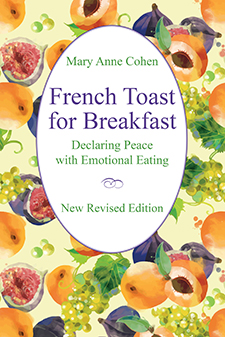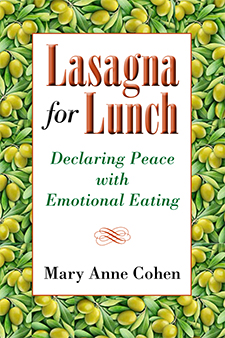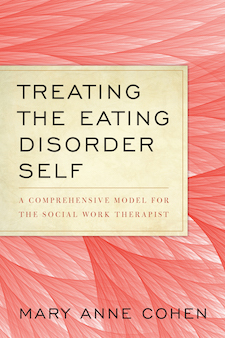Sample Chapter
In 1982, I coined the term “emotional eating” to describe the varied and conflicted, fluctuating and frustrating relationship many people have with food.
- Emotional eating is when you are lonely in the middle of the night and you look for comfort in the refrigerator.
- Emotional eating is when you are angry at someone and you tear and chew into food when you really want to bite that person’s head off.
- Emotional eating is when you feel bored and empty inside and cannot figure out what to do for yourself, so you binge and make yourself throw up.
- Emotional eating is when you refuse to eat and starve yourself because you feel powerless and out-of-control over how your life is going.
- Emotional eating is about using food to distract, detour, or deny your inner emotions.
- Emotional eating is about being hungry from the heart and not from the stomach.
The women, men, and teenagers I work with battle compulsive overeating, body image dissatisfaction, bulimia, binge eating disorder, anorexia, and chronic dieting. Although people abuse food in many different ways—gorging, bingeing and purging, or starving—all emotional eaters use food as a drug that can soothe, comfort, and keep them company, or even as a weapon to sabotage and hurt themselves. No matter where they fall on the spectrum—from an 80-pound anorexic to a 450-pound binge-eater—their relationship with food and their bodies is fueled and driven by emotions too hard to digest— sadness and fear, depression, anxiety, grief, trauma, betrayal, anger, sexual problems, feelings of abandonment and rejection.
My first book, French Toast for Breakfast: Declaring Peace with Emotional Eating(Gürze Books, 1995; Spanish version, Ediciones Piramide, Madrid, 1997), chronicles my own personal journey through compulsive eating and how I resolved this struggle. Then, in 2008, my mother died. I was suffused with such passionate inner contradictions that food beckoned to me once again. A wild mixture of emotions erupted from within me. I felt deep sadness and yearning for her. At the same time, I felt relief that she was dead. I felt an overwhelming love to her for nurturing the very essence of who I am. And I also felt dark anger for the ways she had hurt me. I wanted her back. I wanted her dead. I believed she would return. I hoped she would. I feared she would. I understood she was dead. I could not understand it was forever.
That same year, another family member lay near death until finally receiving a successful heart transplant. Another loved one had a melanoma removed but then needed open heart surgery. Then another family member developed cancer. And I was still recovering from the death of my father two years before.
My world was crushed. I could not contain all these losses and threats of such frightening proportions. I began to overeat again.
A friend gently counseled me, “Maybe in the midst of all these hard times you could become more conscious every day of the people and blessings that you do have. Maybe this is a time to develop more gratitude and a heightened awareness of what is beautiful in your life.”
“No way!” I blurted out. “I just want to go back to taking everybody for granted!”
We both burst out laughing. And all my pent-up anxiety and vigilance about who might die next and what upcoming tragedy lurked on the horizon bubbled to the surface. I realized I could not spend the rest of my life fearing when the next shoe would drop and “regretting the future.” The absurd notion that I wanted nothing more than to return to a life where I could take everyone for granted injected a note of humor during a bleak time and helped me begin to put things back in perspective.
I realized I needed a lot of quiet time to be with my feelings and listen to myself and digest my experiences. I decided to retreat into emotional intensive care and spend some extended time at my country house in the woods of upstate New York. To be with nature. To unplug from the schedule of everyday life in the city. And to spend time with my husband returning to the natural rhythm of sleeping, waking, walking, reading, cooking, enjoying the sounds of the forest. And visiting with my phoebes.
My phoebe birds, small brown birds with long flicking tail feathers, were already in attendance when I first came to my country house over twenty years ago. They had built a nest over the porch light, and every single year found their way back to that very same porch light from wherever they had migrated during the winter. Every spring they returned to lay eggs and raise new babies. I had no idea what generation we were up to, but I loved their rituals. The mama and papa rimmed the nest with bright green spring moss to soften the home for the babies. After weeks of sitting on the eggs, three little fluffs with beaks would hatch and for the next several weeks, mama and papa would fly back and forth feeding their brood. Finally, the day comes when the first baby stands up in the nest, peers tentatively over the edge, stretches its wings, hops up and down, and takes its first choppy short flight. Mama and papa perch anxiously on a nearby tree, chirping their encouragement.
Witnessing the continuity of the phoebe cycle of life and the inevitability of the babies leaving home and the parents flying away after their job is done filled me with a mixture of sadness, yet also peace and hope about the rhythm of life over which I have no control. And I found a measure of quietude in my heart.
Food returned to just being food. Eating returned to just being eating. My pain returned to being my pain. And my pleasure in life returned to being pleasure.
And then this book got born.



